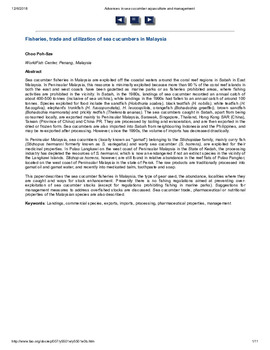Fisheries, trade and utilization of sea cucumbers in Malaysia

Citation
Choo, P.S. (2004). Fisheries, trade and utilization of sea cucumbers in Malaysia. FAO Fish. Tech. Pap. (463): 57-68
Sea cucumber fisheries in Malaysia are exploited off the coastal waters around the coral reef regions in Sabah in East Malaysia. In Peninsular Malaysia, this resource is minimally exploited because more than 90 % of the coral reef islands in both the east and west coasts have been gazetted as marine parks or as fisheries prohibited areas, where fishing activities are prohibited in the vicinity. In Sabah, in the 1980s, landings of sea cucumber recorded an annual catch of about 400-500 tonnes (inclusive of sea urchins), while landings in the 1990s had fallen to an annual catch of around 100 tonnes. Species exploited for food include the sandfish (Holothuria scabra), black teatfish (H. nobilis), white teatfish (H. fuscogilva), elephant’s trunkfish (H. fuscopunctata), H. leucospilota, orangefish (Bohadschia graeffei), brown sandfish (Bohadschia marmorata) and prickly redfish (Thelenota ananas). The sea cucumbers caught in Sabah, apart from being consumed locally, are exported mainly to Peninsular Malaysia, Sarawak, Singapore, Thailand, Hong Kong SAR (China), Taiwan (Province of China) and China PR. They are processed by boiling and evisceration, and are then exported in the dried or frozen form. Sea cucumbers are also imported into Sabah from neighbouring Indonesia and the Philippines, and may be re-exported after processing. However, since the 1990s, the volume of imports has decreased drastically. In Peninsular Malaysia, sea cucumbers (locally known as “gamat”) belonging to the Stichopidae family, mainly curry fish (Stichopus hermanni formerly known as S. variegatus) and warty sea cucumber (S. horrens), are exploited for their medicinal properties. In Pulau Langkawi on the west coast of Peninsular Malaysia in the State of Kedah, the processing industry has depleted the resources of S. hermanni, which is now an endangered if not an extinct species in the vicinity of the Langkawi Islands. Stichopus horrens, however, are still found in relative abundance in the reef flats of Pulau Pangkor, located on the west coast of Peninsular Malaysia in the state of Perak. The raw products are traditionally processed into gamat oil and gamat water, and recently into medicated balm, toothpaste and soap. This paper describes the sea cucumber fisheries in Malaysia, the type of gear used, the abundance, localities where they are caught and ways for stock enhancement. Presently there is no fishing regulations aimed at preventing over-exploitation of sea cucumber stocks (except for regulations prohibiting fishing in marine parks). Suggestions for management measures to address overfished stocks are discussed. Sea cucumber trade, pharmaceutical or nutritional properties of the Malaysian species are also described.
Permalink
Date Available
Type
Publisher
Countries
Copyright
CC BY 4.0
Research Themes
Language